What is Arbitrum? Ethereum’s Layer-2 Scaling Solution Explained
May 02, 2024
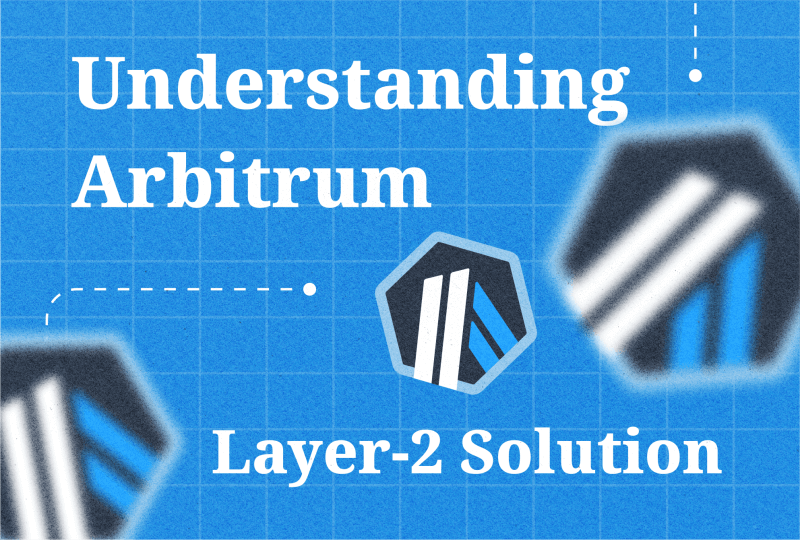
The Ethereum blockchain is a famous decentralized ecosystem for DeFi projects, crypto tokens, and dApps that want to tap into the world of the decentralized economy. Its processing mechanism and smart contracts make DeFi solutions and tools feasible to launch their ecosystems on the ETH network.
This increased adoption led to higher processing fees for various activities. During network congestion, ETH blockchain transactions become more prone to delays and tripled gas fees.
Therefore, layer-2 networks were found to speed up the process and make transactions more affordable. Arbitrum is an ETH blockchain layer-2 scaling solution that keeps Ethereum in the lead for decentralized tokens, tools, and assets. Let’s discover how the Arbitrum chain works and what it offers for its network users.
Key Takeaways
- Arbitrum is a layer-2 scaling solution on the Ethereum blockchain, which improves its throughput and lowers gas fees.
- Using optimistic rollups, Arbitrum contributes by bundling Ethereum transactions and storing them on the mainnet after validating them.
- The Arbitrum ecosystem is highly compatible with Ethereum virtual machines, smart contracts, and other ETH assets, making it highly flexible and scalable for developers and crypto exchanges.
- $ARB is the native token for the Arbitrum network, a utility token for decentralized governance and security voting rights.
Understanding Arbitrum
Arbitrum is a layer-2 blockchain solution for the Ethereum network that is compatible with smart contracts and contributes to the overall improvement of ETH-based transactions and operations.
The Arbitrum network was launched in 2021 by Offchain Labs in the United States. The company had hundreds of dApps and projects in the whitelist to whom they could offer their services.
Layer-2 solutions are tools that offload the mainnet from crammed operations. They share the validation duties and transaction data processing with layer-1 while using the mainnet for block registration as the final step of crypto transactions.
Arbitrum chain processes transactions faster by bundling and sending them as batches to the mainnet for storage while using its computational capabilities to finalise blockchain operations.
The Arbitrum ecosystem is compatible with smart contracts and EVMs, extending the scalability of the Ethereum blockchain. For example, many decentralized exchanges interact with Ethereum-based assets through Arbitrum for faster execution and lower fees.
These features aim to solve the shortcomings of the Ethereum blockchain, such as frequent network congestion, higher gas fees, and delayed processing times.
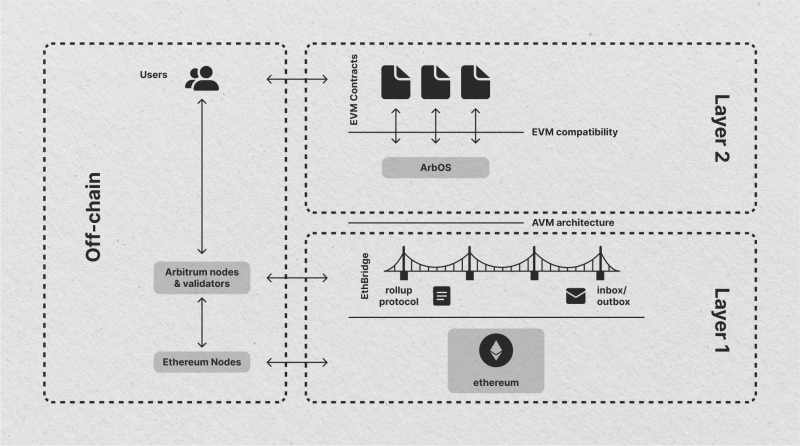
How Arbitrum Layer-2 Works?
Arbitrum uses optimistic rollups, entailing processing crypto transactions in batches and sharing them to the mainnet to validate them at once.
Rollups refer to the process where operations are not validated separately but are compiled together off-chain and are transmitted to layer-1 to verify the whole batch at once. Thus, the “rolled-up” transactions are settled together.
There are four key players in the Arbitrum ecosystem: verifier, key, virtual machines, and manager.

Each participant in the Arbitrum protocol plays a significant role in the unique architecture of this layer-2 chain. The smart contract activity is inserted in the virtual machines (VMs) that run the operations on the ARB ecosystem.
Network managers are responsible for developing the Arbitrum VM activities and tracking their progress per blockchain regulations. Practically, each Arbitrum virtual machine is controlled by a set of managers selected by participants.
Managers are ensured to act in good faith because any malicious activity by the VM is attributed to them, and they might lose their shares in the outcome or reward system.
The key is a core participant in the Arbitrum process, carrying the transaction’s hash address and details. The embedded public keys serve as identifiers that suggest transactions, while private keys are used to sign off on and settle payments.
Finally, verifiers are nodes responsible for checking the transaction’s legitimacy and confirming it according to the blockchain’s protocols.
Each operation on the Arbitrum layer goes through the above stages and enters a batch of several transactions rolled up to the mainnet for storage and registration on the public ledger.
Features of Arbitrum Crypto Scaling Solution
The Arbitrum solution solves common Ethereum issues, such as increased fees, network congestion, and scalability limitations. Let’s find out how this layer-2 chain addresses these issues.
EVM Compatibility
Arbitrum chain is highly compatible with Ethereum virtual machines, with a matching framework and programming language from the basic level. This allows developers to easily build their applications or DeFi projects with Arbitrum on the Ethereum blockchain without learning a new programming framework or language.
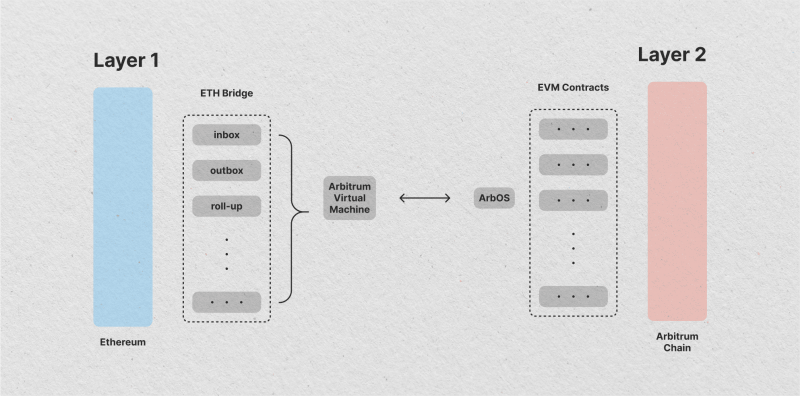
Flexibility
The architecture of Arbitrum makes it easier for developers to build assets, dApps, games, and other utilities using the Arbitrum ecosystem.
This makes the developing phase faster since the setup does not require additional plugins and or software. Instead, the ARB network provides the documentation and tools required to build with layer-2 solutions.
Lower Costs
Arbitrum’s layer-2 solution reduces the fees of transacting with Ethereum in two ways. It offloads the mainnet’s operations, which eases the network congestion and flattens gas fees as demand drops.
Additionally, the optimistic rollup used in the Arbitrum layer decreases the transaction’s average cost, where gas fees are fractionally distributed among operations, making each translation cost less fee.
Advanced Ecosystem
Arbitrum has gone through multiple test phases before launching the mainnet. The release was not accompanied by a token launch, meaning it is not a sale-oriented ecosystem.
Moreover, the foundation targets developers and participants, giving applicants weeks of free development time before releasing a new update. In fact, the developing team had 200+ companies in the whitelist to whom they provided the services before launching the mainnet.
Fast Fact
According to Arbitrum’s portal, the ARB ecosystem is home to over 600 dApps and crypto projects, including games, NFTs, on-ramps, bridges, and more.
Introducing Optimistic Rollups
Arbitrum utilizes optimistic rollups, contributing to fastening the verification process at lower fees. Rollups entail compiling multiple transactions and operations on the layer-2 solution, verifying them, and sending them to the mainnet for storage and registration.
On the other hand, “optimistic” is a characteristic that reduces the required time and effort for the verification process. It refers to the impression that all compiled transactions are compliant with blockchain regulations and, therefore, will be settled with minimum inspection.
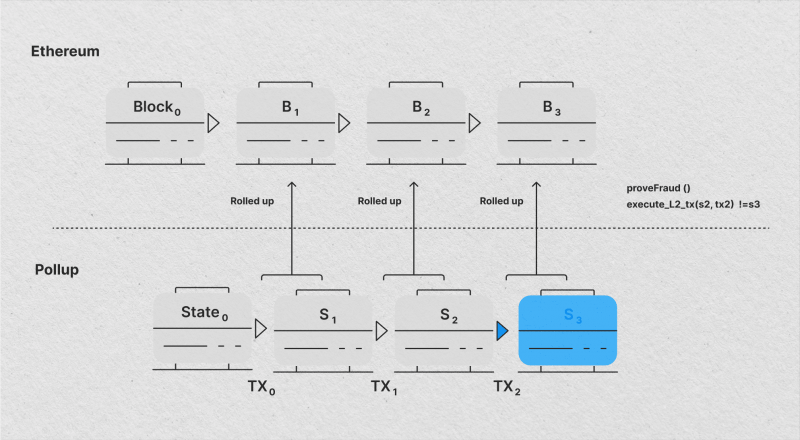
This approach uses a different technique to combat malicious operations or actors. Network participants and nodes have a period to appeal against any transaction after verification, and if a claim is correct, the issuer or validator who processed the operation will be punished.
This motivates parties to act in good faith and increase the rate of verified transactions without any claims so they can receive their rewards and compensation. Hence, they are called “optimistic” because parties are expected to comply with the network regulations. Otherwise, they will get punished.
The other benefit of this approach is having one gas fee charged to the entire set of transactions. The cost is then shared among the batch, resulting in lower fees for a single operation.
Arbitrum Network Products
Since its inception, Arbitrum has been remarkably evolving, making it one of the fastest-growing blockchain scaling solutions. The Arbitrum Foundation has introduced various network upgrades to enhance its offerings. Here are the three main products of the ARB ecosystem.
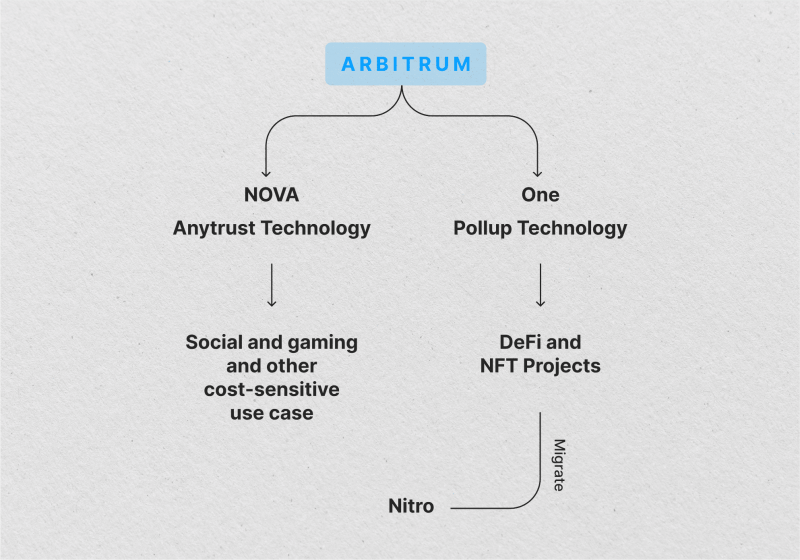
Arbitrum One
Arbitrum One is the mainnet of this layer-2 solution, which was launched on August 31, 2021, by the New York-based software startup, which secured a massive series-B funding round of $120 million, boosting the company’s activities and increasing its value to $1.2 billion.
Major crypto exchanges and businesses have invested in Arbitrum’s products, such as Coinbase, Alameda Research and Pantera Capital. The ecosystem feeds multiple DEXes and crypto projects, such as SushiSwap, UniSwap, Balancer and Curve, which benefit from the increased throughput of the Ethereum layer Arbitrum.
Arbitrum Nitro
One year after the mainnet launch, Arbitrum Nitro was introduced on August 31, 2022, to enhance the ecosystem’s scalability and performance. This update made Arbitrum’s tools more compatible with Ethereum’s virtual machines and enabled it to process transactions faster and cheaper.
This addition attracted more developers because it made the ecosystem compatible with multiple programming languages and allowed participants to run custom EVM contracts to validate blockchain operations.
Arbitrum Nova
The Nova update was also pushed in August 2022, which lowered the associated fees even more. This introduction allows the network to use third-party technology providers for storage services, such as Google Cloud, and use the mainnet only to store data signatures from the storage provider.
This lowered transaction fees because it reduced the storage cost for each individual operation. However, this utility takes away the Ethereum blockchain security features, which might bring some consequences.
Arbitrum Token: ARB
$ARB is the native token of the Arbitrum ecosystem, launched in March 2023 on the Ethereum blockchain with ERC-20 standard.
ARB coin is the centralised payment system for the Arbitrum network with a decentralised governance feature, allowing its holders to participate in the decision making process and dictating future developments.
Network participants can use the ARB token as a crypto investment or to transfer funds across compatible applications and servers.

The Arbitrum coin launch was accompanied by a crypto token airdrop that rewarded early users and significant investors. The Arbitrum Foundation allocated 12.75% of the total ARB coin supply to the ecosystem participants, which amounted to around 1,250 $ARB tokens.
However, the airdrop campaign entailed strict criteria to qualify for getting free ARBs, such as:
- Bridging crypto assets to ARB One or Nova.
- Performing transactions on the Arbitrum network for two months at least.
- Performing four transactions or interacting with four smart contracts on the Arbitrum network.
- Transacting with $10,000 at least.
- Depositing a minimum of $10,000 on ARB One.
- Fulfilling three transactions on the ARB Nova chain.
Three criteria must be met in order to qualify for the ARB token airdrop.
ARB Token Use Cases
Arbitrum Foundation did not use their native token as a means to raise funds or attract investors. In fact, the network managed to secure funds prior to launching their first token. ARB coins serve as utility tokens that offer the following benefits.
Transfer of Funds
ARB coins can be used as a means of payment or transfer between network participants. Users can send and receive $ARB tokens across multiple applications and assets built through the Arbitrum ecosystem.
Decentralized Governance
Token holders can acquire voting rights for crucial network decisions, such as future investments, fund allocation, and technical improvements.
Users must follow the network’s criteria for obtaining the right to vote on Arbitrum DAO network decisions, with transparent processes that enhance the notion of decentralized economies.
Electing Security Council
The decentralized organizational structure includes a council of 12 members who manage the network treasury wallet and the security features. This gives the member more power to vote for how they want their funds, sustaining future developments.
Arbitrum vs. Layer-2 Solutions
Layer-2 chains have become very popular, and crypto development companies are racing to provide the best blockchain scaling solution. These networks are highly crucial for elevating blockchain performance and coping with the increasing demand for decentralized assets.
Aribitrum uses optimistic rollups to process its operations. However, zk-rollup is another type of scaling for the mainnet chain. Zero-knowledge proofs are another approach to verifying transactions at high speed and security.
Instead of registering each transaction separately, Zk-rollups move the computation process off-chain to save data and storage space on the mainnet. Transaction processing is done in batches in the layer-2 network, and then a summary of the changes required to register the block is delivered to the mainnet operators.
Zk-rollup nodes use validity proofs to ensure data integrity. This method uses cryptographic hash checks that verify the block’s correctness without exposing its details, which promotes security and saves time.
Compared with the Arbitrum rollup, zk-rollups are faster because the off-chain contracts undertake the verification process. On the other hand, optimistic rollups are more cost-friendly and are still fast enough.
Conclusion
Arbitrum is an Ethereum-based layer-2 scaling network that solves the shortcomings of the ETH network. Blockchains usually face a few challenges related to increased demands, leading to more delays and higher gas fees.
The Arbitrum layer-2 solution offloads the Ethereum mainnet from congestion by bundling transactions and processing them using AVMs. Network managers program virtual machines to ensure transactions are compliant using optimistic rollups, and then each batch is stored on the layer-1 blockchain.
The Arbitrum network is highly scalable and compatible with Ethereum’s assets, such as virtual machines, smart contracts, and associated apps and tokens. It is an open-source framework that allows developers to power their digital assets and build their crypto solutions.
Crypto exchanges and decentralized liquidity funds use the ARB ecosystem to build their software and offer fast and reliable transactions.
FAQ
What is Arbitrum?
Arbitrum is a layer-2 solution on the Ethereum blockchain used to build decentralized apps, DeFi tools, and exchanges using its fast processing capabilities and low cost.
Is Arbitrum safe?
Besides using the highly reliable Ethereum security system, Arbitrum’s optimistic rollup ensures data correctness and minimizes security risks.
How does Arbitrum work?
The Arbitrum scaling chain improves network throughput and lowers transaction costs by batching operations and sending them to the mainnet simultaneously while distributing the gas fees on the whole bundle.
What makes Arbitrum unique?
Arbitrum is highly compatible with Ethereum’s assets, such as EVMs and smart contracts, emphasising developers’ openness and flexibility to participate, upgrade, and build their Web 3.0 applications.




